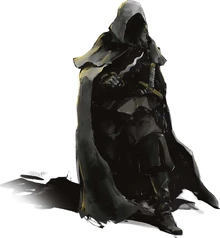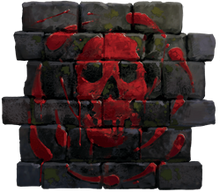
A worshiper of Bhaal.
Bhaal (pronounced Beh-HAHL)[1], the Lord of Murder, was a god of death who favored murders that were carried out through violent or ritualistic means.[6] Originally a mortal of Toril, Bhaal ascended to godhood along with Bane, the Lord of Tyrants, and Myrkul, the Lord of the Dead. The trio took on the portfolio of the ancient deity Jergal, and came to be known as the Dead Three.[4] Gugari worshipers knew Bhaal as Niynjushigampo.[7]
The Lord of Murder was feared throughout all of Faerûn—especially on the island realm of the Moonshaes.[8] Despite this shared dread throughout the Realms, the exact nature of what the Lord of Murder had power over was contested among sages and scholars—in his best incarnation he might have taken strength in violently punishing murderers and warmongers. Challengers of this notion insisted that he judged whether a murder was righteous or not.[citation needed] Yet another ideal was propagated by the Bhaalspawn, his half-mortal children who had been spawned on Toril, who insisted that he simply wanted more murder.[9]
Divine Realm
In the centuries before the Time of Troubles, Bhaal’s divine realm was the Throne of Blood on Khalas, the first layer of the outer plane of Gehenna.[8]
Worshipers
The clergy of Bhaal in Faerûn were known as Bhaalists or Bhaalyn, the latter being used more commonly in the lands east of the Dragon Reach. Together they were an disorderly network of local hierarchies,[8] with the urban and rural branches maintaining distant relations from one another. Collectively, they believed that murder was both a duty to their god and a game for their enjoyment. Each cleric of Bhaal was expected to perform at least one murder every tenday, in the darkest moment in the dead of night.[10]
- Deathstalkers
During the time that he was dead, Bhaal had many scattered cultist groups, the most infamous being the Deathstalkers of Bhaal,[11] who attempted to bring him back to life. For a while after the Bhaalspawn crisis, it was believed his essence had been locked away on the Upper Planes, preventing his resurrection permanently. However, this proved to be incorrect. Bhaal's essence had been preserved in his half-mortal children, the Bhaalspawn, and after the death of the last two Bhaalspawn,[12] Bhaal was revived.[13]
Relationships
A wholly evil, debased and sadistic god, Bhaal was reviled by a majority of the pantheon; his divine foes included Chauntea, Helm, Ilmater, Lathander, Lliira and Tyr. Bhaal was served by the goddesses Talona and Loviatar,[8] who in turn served Bane[14] and to a lesser extent, Myrkul.[citation needed]
Powers

The violent symbol of Bhaal.
Avatars
Bhaal had three avatar forms: a shape-shifting monstrosity called Kazgoroth, a corpse-like male humanoid called the Slayer, and a gargantuan beast known as the Ravager. The Lord of Murder preferred to assume the form of the Slayer when in urban areas. It resembled a humanoid corpse with a feral face; its ivory skin being inset with deep lacerations flowing with black ichor. The Ravager, which Bhaal assumed when visiting the rural regions of Toril, was a 30' (9.1m) monster with a twisted, grimacing face that featured a flowing beard and mane, 7' long (2.1 m) horns and eyes full of the flames of Gehenna.[8]
In some extreme cases, Bhaal's mortal Bhaalspawn children could actually turn into creatures that were said to be these avatars after his death; however, these creatures were even more monstrous and inhuman in shape, acting as little more than powerful killing machines. While powerful, they were weaker form than a true god's avatars.[15]
History
Mortal
Before his ascension to godhood, Bhaal was a power-hungry adventurer on Toril. Along with his companions Bane and Myrkul Bey al-Kursi, he sought to attain the portfolio of the God of the Dead Jergal. After defeating one of the Seven Lost Gods, the three were able to travel to Jergal's domain, the Castle of Bone in the Gray Waste. Upon their arrival, Jergal willingly offered his realm to the Dark Three, though they couldn't decide amongst themselves who would rule.[16]
Upon Jergal's suggestion, the three divided his power, deciding how to divide it based on the outcome of a game. The three played a game of knucklebones, and Bane emerged as the victor. He claimed the domains of hatred, strife and tyranny as his own. Myrkul, coming second, chose rule over the dead, the ultimate fate for all of Bane's minions. Finally, Bhaal chose the divine province of death. As he said:[16]
Godhood
While Bhaal was originally the patron deity of assassins and their victims, it wasn't long before common murderers used a claim of his worship to justify their sadistic actions, warping the manner of his worship.[citation needed]
Time of Troubles
On Eleint 16, 1358 DR, having lost his powers and being forced to walk Faerûn like the rest of the gods, Bhaal was slain by the upstart mortal Cyric using the avatar of Mask, a sword named Godsbane. In doing this, Cyric stole Bhaal's divinity and portfolio elements.[17] However, much like Myrkul—who invested his divine essence in the artifact known as the Crown of Horns—Bhaal was not utterly removed from Faerûn. Part of his divinity remained in the Winding Water, around Boareskyr Bridge where he was slain, his blood having flowed into the river.[8] More importantly, Bhaal foresaw his death and impregnated many mortal women, creating his heirs, the Bhaalspawn.[17] The Bhaalspawn were involved in a series of conflicts along the Sword Coast, with one standing above the others and ultimately foiling Bhaal's plan to return through his children.[18]
After the death of the Lord of Murder, the city-dwelling Bhaalists quickly converted to the worship of Cyric, whom they referred to as Cyric-Bhaal. The rural priests maintained their faith for years to come, claiming they continued to receive their divine powers following their nightly prayers. The schism between Bhaal's remaining followers and the emerging Cyric-Bhaalists reached its apex in 1367 DR, getting to the point where the factions would ambush and assault one another. Soon later, the remaining worshipers of Bhaal stopped receiving their divine powers and began gradually converting to Cyricism or Xvimism.[8]
Reemergence
For a time, it was believed that any possibility for Bhaal's resurrection had been stopped. The last known Bhaalspawn, Abdel Adrian, resisted the murderous impulses caused by his lineage and became a famed and beloved figure in the city of Baldur's Gate. In 1482 DR, near the beginning of the era known as the Second Sundering, Viekang, another Bhaalspawn who was thought to be dead, attacked Adrian as he spoke to a crowd in the portion of town known as The Wide. While the ultimate winner of the duel is unknown, the victor transformed into a massive, blood-soaked creature and began a rampage that was only stopped when a group of adventurers new to Baldur's Gate defeated and killed the monstrosity.[12]
With all of his children dead, all of Bhaal's essence was freed, allowing for his resurrection. Bhaal was revived, and reclaimed the murder domain from Cyric.[13]
Appendix
| This article is incomplete. You can help the Forgotten Realms Wiki by providing more information. |
Further Reading
- Thomas M. Costa (August 2004). “Faiths of Faerûn: Deathstalkers of Bhaal”. In Matthew Sernett ed. Dragon #322 (Paizo Publishing, LLC), pp. 92–94.
Appearances
- Novels
- Tantras • Waterdeep
- Video Games
- Baldur's Gate: Siege of Dragonspear • Baldur's Gate II: Throne of Bhaal
- Board Games
- Betrayal at Baldur's Gate
External links
 Bhaal article at the Baldur's Gate Wiki, a wiki for the Baldur's Gate games.
Bhaal article at the Baldur's Gate Wiki, a wiki for the Baldur's Gate games.
References
- ↑ 1.0 1.1 1.2 Ed Greenwood, Jeff Grubb (August 1987). “Cyclopedia of the Realms”. In Karen S. Martin ed. Forgotten Realms Campaign Set (TSR, Inc.), p. 10. ISBN 0-88038-472-7.
- ↑ 2.0 2.1 Steve Kenson, et al. (November 2015). Sword Coast Adventurer's Guide. Edited by Kim Mohan. (Wizards of the Coast), pp. 21, 27. ISBN 978-0-7869-6580-9.
- ↑ Mike Mearls, Jeremy Crawford, Christopher Perkins, James Wyatt (2014). Dungeon Master's Guide 5th edition. (Wizards of the Coast), pp. 96–97. ISBN 978-0786965622.
- ↑ 4.0 4.1 Richard Baker, Ed Bonny, Travis Stout (February 2005). Lost Empires of Faerûn. Edited by Penny Williams. (Wizards of the Coast), pp. 41–42. ISBN 0-7869-3654-1. Cite error: Invalid
<ref>tag; name "LEoF-p41" defined multiple times with different content - ↑ Julia Martin, Eric L. Boyd (March 1996). Faiths & Avatars. (TSR, Inc.), pp. 44–45. ISBN 978-0786903849.
- ↑ Julia Martin, Eric L. Boyd (March 1996). Faiths & Avatars. (TSR, Inc.), p. 44. ISBN 978-0786903849.
- ↑ David Cook (August 1990). The Horde. Edited by Steve Winter. (TSR, Inc.), p. Cannot cite pages from this boxed set. See {{Cite book/The Horde}} for a list of citations that may be used.. ISBN 0-88038-868-4.
- ↑ 8.0 8.1 8.2 8.3 8.4 8.5 8.6 Julia Martin, Eric L. Boyd (March 1996). Faiths & Avatars. (TSR, Inc.), p. 45. ISBN 978-0786903849. Cite error: Invalid
<ref>tag; name "F&A-p45" defined multiple times with different content - ↑ BioWare (December 1998). Designed by James Ohlen. Baldur's Gate. Black Isle Studios.
- ↑ Julia Martin, Eric L. Boyd (March 1996). Faiths & Avatars. (TSR, Inc.), p. 46. ISBN 978-0786903849.
- ↑ Julia Martin, Eric L. Boyd (March 1996). Faiths & Avatars. (TSR, Inc.), p. 47. ISBN 978-0786903849.
- ↑ 12.0 12.1 Ed Greenwood, Matt Sernett, Steve Winter (August 20, 2013). “Campaign Guide”. In Dawn J. Geluso ed. Murder in Baldur's Gate (Wizards of the Coast), p. 3. ISBN 0-7869-6463-4.
- ↑ 13.0 13.1 Steve Kenson, et al. (November 2015). Sword Coast Adventurer's Guide. Edited by Kim Mohan. (Wizards of the Coast), p. 17. ISBN 978-0-7869-6580-9.
- ↑ Julia Martin, Eric L. Boyd (March 1996). Faiths & Avatars. (TSR, Inc.), p. 36. ISBN 978-0786903849.
- ↑ BioWare (September 2000). Designed by James Ohlen, Kevin Martens. Baldur's Gate II: Shadows of Amn. Black Isle Studios.
- ↑ 16.0 16.1 Julia Martin, Eric L. Boyd (March 1996). Faiths & Avatars. (TSR, Inc.), p. 37. ISBN 978-0786903849.
- ↑ 17.0 17.1 Richard Baker, Ed Bonny, Travis Stout (February 2005). Lost Empires of Faerûn. Edited by Penny Williams. (Wizards of the Coast), p. 42. ISBN 0-7869-3654-1.
- ↑ BioWare (June 2001). Designed by Kevin Martens. Baldur's Gate II: Throne of Bhaal. Black Isle Studios.
Connections
Azuth • Bane • Bhaal • Chauntea • Cyric • Gond • Helm • Ilmater • Kelemvor • Kossuth • Lathander • Loviatar • Mask • Mielikki • Myrkul • Mystra (Midnight) • Oghma • Selûne • Shar • Shaundakul • Silvanus • Sune • Talos • Tempus • Torm • Tymora • Tyr • Umberlee • Waukeen
Other Members
Akadi • Auril • Beshaba • Deneir • Eldath • Finder Wyvernspur • Garagos • Gargauth • Gerron • Grumbar • Gwaeron Windstrom • Hoar • Istishia • Iyachtu Xvim • Jergal • Lliira • Lurue • Malar • Milil • Nobanion • The Red Knight • Savras • Sharess • Shiallia • Siamorphe • Talona • Tiamat • Ubtao • Ulutiu • Valkur • Velsharoon
Major Human Deities of Faerûn
Angharradh | Bane | Bhaal | Chauntea | Corellon Larethian | Garl Glittergold | Gruumsh | Horus-Re | Lathander | Moradin | Myrkul | Mystra | Oghma | Shar | Silvanus | Sune | Talos | Tempus | Tyr | Yondalla
Other Human Deities of Faerûn
Auppenser | Abbathor | Arvoreen | Auril | Baervan Wildwanderer | Berronar Truesilver | Beshaba | Callarduran Smoothhands | Clangeddin Silverbeard | Cyrrollalee | Deep Duerra | Deep Sashelas | Dumathoin | Erevan Ilesere | Flandal Steelskin | Gond | Hanali Celanil | Helm | Ilmater | Isis | Labelas Enoreth | Laduguer | Lolth | Mask | Mielikki | Nephthys | Osiris | Rillifane Rallathil | Sehanine Moonbow | Segojan Earthcaller | Selûne | Set | Sharindlar | Sheela Peryroyl | Solonor Thelandira | Thoth | Tymora | Umberlee | Urdlen | Vergadain
